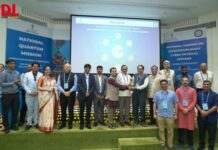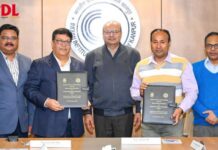 Timir Kumar Sengupta, Principal, Ram Ratna Vidya Mandir has 35 years of teaching experience in residential and day scholar as well as International schools. He has 20 years of experience as a Principal. In conversation with digitalLEARNING magazine, he talks about various components of education for the development of students…
Timir Kumar Sengupta, Principal, Ram Ratna Vidya Mandir has 35 years of teaching experience in residential and day scholar as well as International schools. He has 20 years of experience as a Principal. In conversation with digitalLEARNING magazine, he talks about various components of education for the development of students…
Please share the vision of Ram Ratna Vidya Mandir.
Ram Ratna Vidya Mandir aspires to develop socially conscious Indian citizens of tomorrow who will provide enlightened leadership in all walks of life. The school’s vision is set with a futuristic view that students are the leaders of tomorrow. They are the ones who would not only lead their family but also the country to the path of progress. A progressive and developed country is the one which has its foundation strongly built upon with citizens who are not only intellectually but also socially and spiritually developed.
Being Mathematics teacher to Principal, how has your journey been?
I started my career as a mathematics teacher and hostel-in-charge way back in 1977. As my grandfather and father were teachers, we are the third generation in the family who took up teaching as a profession. Though there was no monetary gain but this profession is definitely the most prestigious one. My journey in the educational field has been an enriching experience from being Vice-Principal from 1995 to 2000 at Jay Jyoti School, Jaypeenagar and 2001 onwards as a Principal of Bhartiya Vidya Bhavan (Tripura), Central Model School (Kolkata), Singhania Public School (Gujarat), Podar International School (Jalna), Arunodaya Public School (Thane) and Ram Ratna Vidya Mandir at present.
How does Continuous and Comprehensive Evaluation (CCE) practice, according to you, caters to holistic development of students?
CCE Pattern is a marvelous achievement of CBSE. It caters to the holistic development of the students thus making education an exciting journey rather than a burden. This pattern has been positively accepted by the teachers as well as the students. For the teachers, it gives an opportunity to evaluate students at various levels rather than what they memorise. For the students, it gives them an opportunity to portray the best in them albeit without the pressure of rote learning or learning without comprehending.
The ICT has become an indispensible part of the educational institutions in the modern times
How you utilise the potential of ICT in the school?
Education today has undergone tremendous change. The ICT has become an indispensible part of the educational institutions in the modern times. In the teaching process. ICT is actually addon experience that enables the teachers to take their students beyond the classroom experience. Administration obviously has become hassle free with ICT. In my school, we have an AV room well utilised by the teachers and we are in the process of installing Smartclass solutions.
How has training being imparted to the teachers on a continuous basis?
I believe that teaching profession is such that it should never be stagnant. Knowledge is ever growing and ever flowing. I make various arrangements for in-house as well as external experts’ training to my teachers. They are also sent to various seminars, conferences and workshops as per their subjects, so that they are constantly upgrading themselves. The teachers and students are also sent for exchange programmes to other schools for knowledge sharing.
Please comment on the success of open-book examination system in Standards X and XII proposed by CBSE?
Open book test is a system, that needs to be researched upon. It also involves value inculcation in the students. Focused efforts are required to bring this system into practice, which if implemented properly would definitely make this system a success.
Please share the innovations done by the school in last five years. What are the future plans of the school?
We have child centric educational system which involves activity based teaching that goes beyond classrooms. Subjects that are abstract like science, maths and social science have well developed laboratories that make learning fun and realistic with hands on experience. The school also has its Eco club with a difference, unlike the regular clubs which are inside the school building; this is a botanical park which has all rare and exotic plants. The gardening work is carried out by the students with the help of teacher in charge. Various other clubs like English literary, music, art and painting are in place to bring out the hidden talents in children. These are reflected through the competitions and exhibitions that take place throughout the year. Individual differences are taken well into account. The school has a good supportive Sports Department which caters to sports like Football, Cricket, Volleyball, Handball, Table Tennis, Swimming, Chess, and others. The students participate in various district, state and national as well as international level sports competitions.
What is your opinion on the role of sports and physical education in the overall development of a child?
Being an ardent follower of Swami Vivekanand, I believe that education should cater to character formation, strengthening of mind and expansionof intellect which will enhance the personality of a student and enable him to stand on his own feet. As I am a post graduate in Sports management from Kolkata and NIS certificate holder in football from NISS, I have experienced the significance of sports in one’s life and believe that it helps in the overall development of a child.








 Vivek Agarwal
Vivek Agarwal Company Name
Company Name Rajeev Singh
Rajeev Singh

 Eduard Metzger
Eduard Metzger











